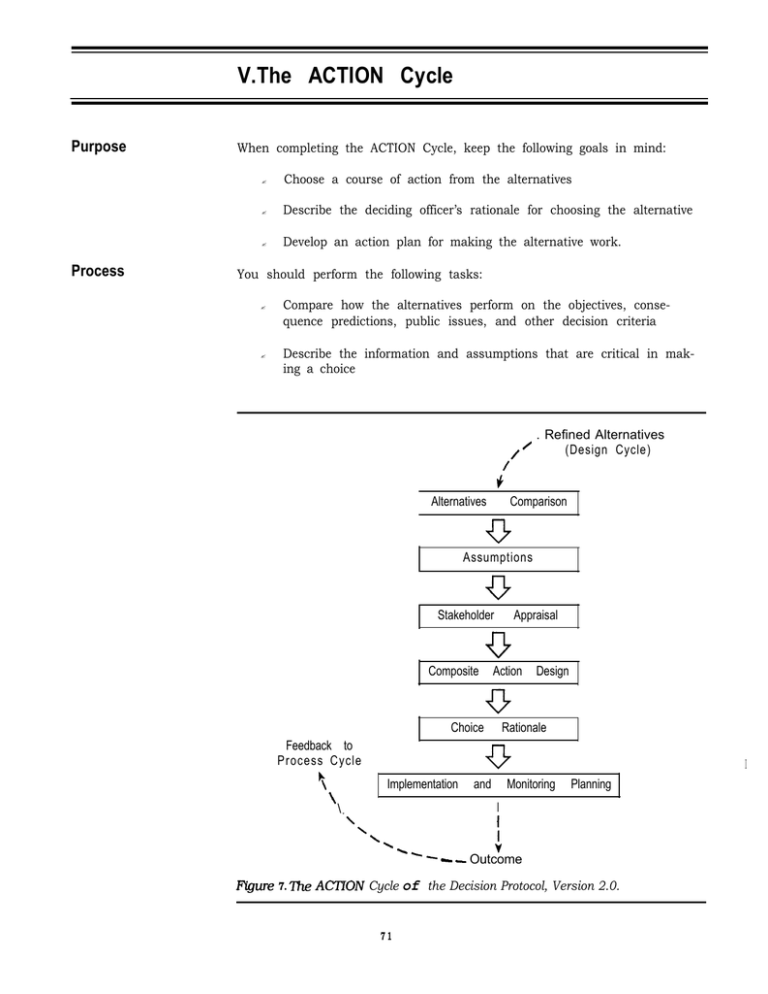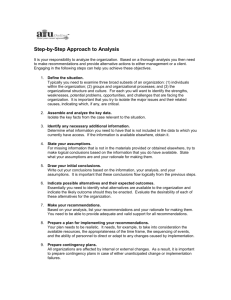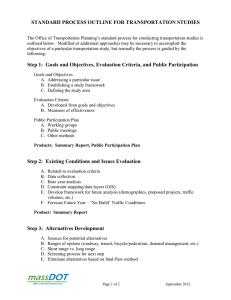V.The ACTION Cycle Purpose
advertisement

V.The ACTION Cycle Purpose Process When completing the ACTION Cycle, keep the following goals in mind: ? Choose a course of action from the alternatives ? Describe the deciding officer’s rationale for choosing the alternative ? Develop an action plan for making the alternative work. You should perform the following tasks: ? ? Compare how the alternatives perform on the objectives, consequence predictions, public issues, and other decision criteria Describe the information and assumptions that are critical in making a choice / 0 . Refined Alternatives (Design Cycle) f’ Alternatives Comparison 0 Assumptions 0 Stakeholder Appraisal Composite 0 Action Design 0 Choice Rationale Feedback to Process Cycle Implementation c\ \ 0 and Monitoring I Planning I \ -\ \ I \ . . i +Z - - Outcome Figure 7. The ACTION Cycle of the Decision Protocol, Version 2.0. 71 ? ? ? Products Describe the rationale for choosing the alternative, including what is gamed and what is foregone f-2 Choose an alternative or construct a new action from the features of the alternative set. You should prepare the following products: ? A description of the selected alternative ? A narrative description of selection rationale ? A display of trade-offs among important measures and criteria. ? Initial Assessment Questions Evaluate the alternatives under varying assumptions about critical information A written plan to ensure that the action is implemented and monitored and that contingencies are provided for. Put a check beside each statement below that is true about any choice of action you may have already taken on the problem. For each statement unchecked, work through the Core Question suggested or describe what should be done to bring the action analysis “up to grade.” If you check fewer than half of the assessment questions, work completely through the ACTION Cycle Core Questions. - The display of expected consequences of all alternatives is understandable. If this statement is not true, go to ACTION Core Question 3. ‘_ .: - The benefits, costs, risks, and trade-offs that would occur with different alternatives are understandable. If this statement is not true, go to ACTION Core Questions 3 and 9. - The criteria for the choice of alternatives are clearly stated. If this statement is not true, go to ACTION Core Questions 3, 4 and 7. - The relative importance of different objectives, consequences, and other criteria are clearly presented. If this statement is not true, go to ACTION Core Questions 3 and 7-9. - The rationale is candid about biases that could have influenced the choice. If this statement is not true, go to ACTION Core Questions 4-5. - The strengths and limitations of critical assumptions and information sources are clearly described. If this statement is not true, go to ACTION Core Questions 4-5. - Stakeholder concerns have been addressed in the choice rationale. If this statement is not true, go to ACTION Core Questions 2 and 7-9. * 72 - The rationale for choosing the alternative is understandable and well-presented. If this statement is not true, go to ACTION Core Questions 7-9. - The alternative chosen fully addresses the objectives set out by the team and stakeholders. If this statement is not true, go to ACTION Core Questions 3 and 7. - The alternative chosen is consistent with organizational policies and plans at higher scales of authority. If this statement is not true, go to ACTION Core Questions 7-9. - The organization’s legal and other authorities to implement the activities chosen are clear. If this statement is not true, go to ACTION Core Questions 7-9. - The choice process relies strongly on the results of the CONSEQUENCES Cycle analysis. If this statement is not true, go to ACTION Core Question 3. - The choice rationale results from the process design developed by the team and stakeholders. If this statement is not true, check PROCESS Core Question 8 and ACTION Core Question 7. - The choice rationale is logically defensible. If this statement is not true, go to ACTION Core Questions 7-9. - The choice rationale is legally defensible. If this statement is not true, go to ACTION Core Questions 7-9. - The selected alternative is technically, f%nancially, and logistically feasible. If this statement is not true, go to ACTION Core Questions 10 and 13. - The plans for control and accountability are clear and comprehensive. If this statement is not true, go to ACTION Core Questions 10-16. 73 ACTION Core Questions Alternatives ” Comparison (Note: Record results of ACTION Core Qistion 1 in AClYON Summary ACTION Core Question 1 How do the alternatives compare in meeting the objectives and minimizing negative consequences? Table 1.) Summarize the consequence predictions from the CONSEQUENCES Cycle. Review the results of CONSEQUENCES Summary Table 4 for each of the alternatives and the overall comparison in DESIGN Summary Table 6. It is important to include the no-action and the current or status quo alternatives. Compaie the performance of the alteinatives, giving each a relative rating or ranking for each measure. Use an intuitive approach or a structured analysis, discussion technique, weighted rating or ranking process, or multiattribute utility analysis such as those explained in Appendix A, Team Leader Tips and Tools, and Appendix C, For Further Reading. Identify the technique you are using. Summarize your comparisons by providing an overall ranking and describing the pluses and minuses for each alternative relative to the others. ACTION S ummary Table 1. Alternative Ratings (ACTION Core Question 1) Consequence Rating or Ranking Measure Current Action Vo Action Alternative A Objectives Measure 1 Objectives Measure 2 Side Effects Measure 1 Side Effects Measure 2 Overall ranking for the alternative Relative advantages (pluses) Relative disadvantages (minuses) 75 Wernative B Combined or Hybrid Alternative Highest RatedRanked Alternative for Measure Assumptions ACTION Core Question 2 (Note: Record results of your discussions on ACTION Core Questions 24 in ACTION Summary Table 2.) What are the most critical assumptions in your comparison? Describe the most critical factors or information in the comparison above. These can be assumptions about measures, alternatives, stakeholder perceptions, or other elements of the analysis. Cycle back to the DESIGN and CONSEQUENCES summary table results, if necessary. What did you assume about each of these factors? ACTION Core Question 3 How would your ranking of the alternatives change if the assumptions were different? Indicate which of the assumptions above are the most uncertain. For each assumption, describe your confidence (certainty) level (0 = no confidence to 10 = highest confidence). For the most uncertain and critical assumptions above, assume that the opposite or drastically different conditions will materialize. Describe how your ranking of the alternatives would differ under these different conditions. This is called sensitivity analysis. ACTION Core Question 4 What additional information will you (or the deciding officer) need to more fully compare the alternatives and choose one? ACTION Summary Table 2. Assumptions for Choice (ACTION Core Questions 24) Assumption (A-2) Confidence Level (0 to 70) (A-3) Opposing Assumption 76 (A-3) Alternative Ranking Under Opposing Assumption (A-3) Information (A-4) Needs -: Stakeholder Appraisal (Note: Record results of ACYlYON Core Question 5 in AC77ON Summarg Table 3.) ACTION Core Question 5 How will stakeholders respond to the alternatives? . For each alternative. describe stakeholders and whether, in your opinion, they would support it, oppose it. or be neutral. Describe what you think are the reasons for their views. ACTION Summary Table 3. Stakeholder Responses (ACTION Core Question 5) Stakeholder Stakeholder Stakeholder 1 Stakeholder 2 Overall “net” view of the alternative Current Action Responses No Action Expected (Support/Neutral/Oppose) and Reasons Alternative A A/t erna tive B -I Combined or Highest Hybrid Rated/Ranked Alternative (A-6) Alternative for Stakeholder Composite Action Design (Note: Record results of AC7YON Core Question 6 in ACTION Summary Table 4 below.) ACTION How might you combine features of the alternatives into an action that would outperform the existing alternatives? Core Question 6 This same question was asked of the analysis team in the DESIGN Cycle. The version here gives the deciding officer and the team a second opportunity to refashion a more robust alternative after a closer look at all the objectives, consequence predictions, expected stakeholder responses, and other feedback. . ACTION Summary Table 4. Composite Alternative (ACTION Core Question 6) I. Alternative Activity Description 78 . . ,,_. Choice Rationale (Note: Record results of ACTION Core Questions 7-10 in ACTION Summary Table 5. following ACTION Core Question 10.) ACTION Core Question 7 What alternative action do you prefer? Why? Describe the alternative action that creates the most desirable and feasible combination of changes in the situation. Describe what makes your selected alternative better than the others. List the factors, measures, or features that drive your preference. ACTION Core Question 8 What keeps you from selecting each of the other alternatives? Explain how each alternative not selected may not perform as well as your selected alternative on objectives, side-effects, costs, or other criteria. For each alternative not selected, display the rationale for the nonselection in ACTION Summary Table 5, after ACTION Core Question 10. ACTION Core Question 9 What do you give up (trade off) by selecting the alternative you did? Describe the benefits or opportunities that will not be realized (trade-offs) if you implement the preferred alternative. In other words, what do the other alternatives offer that you will forgo in your choice of actions? List the stakeholders who will be most affected or will respond most strongly to these trade-offs. ACTION Core Question 10 What aspects of the selected action are negotiable? List those activities, refinements, or other features of the selected altemative that you may be able to forgo or modify in negotiations with powerful stakeholder groups or internal interests. Describe the levels or types of activity that must be retained for the alternative to meet objectives and keep unwanted consequences to acceptable levels. Describe the negotiable and nonnegotiable features in ACTION Summary Table 5. 79 ACTION Summary Table 5. Rationale for Choice [ACTION Current Action No Action Core Questions 7-10) Combined or Hybrid Alternative A Alternative 8 (after refinement) (after refinement) Alternative : - Preference (select one or rank) (A-7) Factors for selection (A-7) Nonselection factors (A-8) Trade-offs selection preferred (foregone with of (A-9) features) Stakeholders affected (A-9) Negotiable features (for selected alternative) (A-10) Nonnegotiable features (for selected alternative and others) (A-10) -‘. 80 lmplemen ta tion (Note: Record results of ACTION Core Questions 1 l-l 3 in ACTION Summary Table 6, following ACTION Core Question 13.) ACTION Core Question 11 What must be done to ensure that the action will be implemented? Develop an action/implementation plan for your selected alternative. Describe the specific activity, who is responsible, deadlines, and other particulars. ACTION Core Question 12 What stipulations or conditions will be necessary for partners, users, and others? Describe the contents of any contracts, covenants, agreements, or supervision necessary to implement each of the activities. ACTION Core Question 13 Who are the key players in making this action accomplish its objectives and be successful? List the people, groups, or coalitions inside the agency who must be convinced that this action is worthwhile. Describe how the preferred action does or does not meet their particular needs and goals. Describe what you can do to gain or maintain their support. , 81 ACMON Summary Table 6. Implementation Plan (ACTION Core Questions 11-13) Activity (A- 11) Who (A-l 1) When (A- 11) Stipulations (A- 12) 82 Key P/ayes (A-13) Support Basis (A-13) (Note: Record results of ACTION Core Question 14 in ACTION Summary Table 7, below.) ACTION Core Question 14 What could go wrong during the implementation of this action? Develop several “worst-case” accident, mistake, or natural disaster scenarios. Describe how you or future decision teams could respond to each of these scenarios to achieve the original objectives or minimize negative consequences. ACTION Summary Table 7. Worst-Case Scenarios (ACTION Core Question 14) fey Uncertainties Scenario Responses 83 (Note: Record results of ACTION Core Questions 15-l 7 in ACTION Summary Table 8, following ACTION Core Question 17.) ACTION Core Question 15 How will you monitor the action to see that its activities are implemented? (implementation monitoring) Describe the responsible parties, information to be collected, documentation requirements (including reporting milestones and timelines), and corrective actions. ACTION Core Question 16 How will you monitor the action to determine whether the activities will have the consequences you predicted? (consequence monitoring) Describe the responsible parties, information to be collected, documentation requirements (including reporting milestones and timelines), and corrective actions. ACTION Core Question 17 How will you document and record this action so that future teams can learn from its successes and failures? Imagine yourself 10 years in the future as a part of a decision team facing a similar or related decision about this area or situation. What information would you like to have in the administrative record and project files to help you? Describe how you will incorporate these needs into the action plan and into the administrative record for this action. ACTION Summary Table 8. Monitoring and Learning Plan (ACTION Core Questions 15-17’) Implementation Monitoring Consequence Monitoring (A- 15) (A-16) Who Information to be collected When Corrective responses and actions 84 Learning Design (A- 17) Audit Questions Reanswer the Initial Assessment Questions in this cycle. If you are unsatisfied with any of the answers, return to the appropriate Core Questions. See Appendix A for process suggestions. 85




